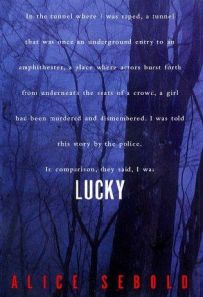* Minor spoilers.
Alice Sebold certainly has a knack for writing arresting and captivating first sentences:
When all is said and done, killing my mother came easily.
 The novel opens with Helen Knightly finally breaking down under the stress of looking after her invalid and elderly mother and suffocates her. The murder is an uncomfortable hybrid of a mercy killing of a diseased riddled body and also out of spite against a cold and loveless mother. After the murder, Helen is filled with guilt and remorse but also relief. As Helen tries to comprehend what she has done and its consequences, she also revisits her childhood having grown up in a rather dysfunctional household.
The novel opens with Helen Knightly finally breaking down under the stress of looking after her invalid and elderly mother and suffocates her. The murder is an uncomfortable hybrid of a mercy killing of a diseased riddled body and also out of spite against a cold and loveless mother. After the murder, Helen is filled with guilt and remorse but also relief. As Helen tries to comprehend what she has done and its consequences, she also revisits her childhood having grown up in a rather dysfunctional household.
As an only child born to a mature couple, Helen’s presence is more of an interruption than a welcomed addition to the lovers. As the reminiscences progresses, we find the fraught position Helen is in. Her mother, a severe agoraphobic for almost all of Helen’s life and who lived her life completely housebound, could not leave her house to even save a dying boy in her front yard or to protect her only child from an angry mob of men from assault. Her father, with the veneer of a loving and stable father and husband slowly crumbles from the weight of depression which tragically ends when he shoots himself in the head and Helen is forced to clean up his blood at her mother’s insistence.
The novel is ultimately not about the murder but a study of the complex relationship between parent and child, mother and daughter. Helen herself have two daughters and must now face up that her action has changed all their lives. It is also about mental illness and the way it has been, how it is, misunderstood or incomprehensible.
Some reviews of this book has been less than complimentary. As a stand-alone novel, I liked it but when it is compared with Sebold’s earlier two novels, while The Almost Moon does not measure up it is still a remarkable read.

